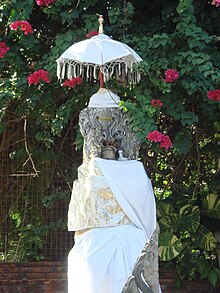Dang Hyang Nirartha

Danghyang Nirartha, also known as Pedanda Shakti Wawu Rauh, was a Shaivite religious figure in Bali and a Hindu traveler, during either the 15th century[1] or 16th century.[2] He was the founder of the Shaivite priesthood in Bali.[3]
He is also called Pedande Sakti Wawu Rauh[4] (the newcomer of Holy Priest); in Lombok he is known as Pangeran Semeru, and in Sumbawa as Prince Sangupati.[5]
Early life[edit]
He was a disciple of Syekh Siti Jenar,[6] a Javanese member of the Wali Sanga in Java who proned a more mystical approach of sufism,[7] called pantheist sufism (union of man and God, wujûdiyah, manunggaling kawulo gusti) - which opposed chariatic sufism such as that of Sunan Kudus.[8]
Travelling to Bali: politics[edit]

| Part of a series on |
| Shaivism |
|---|
 |
|
|
Nirartha, respected priest, was sent by the Javanese royal court of Blambangan to Bali in 1537 to bring the support of the spiritual world (niskala) - and the sanction of Java's earthly powers - to confirm Dalem Baturenggong's Gelgel kingship over Pasuruan, Blambangan, Puger, Bali, Nusa Penida, Sasak, and Sumbawa. He was to select a local priest who would lead the rajasurya or aswameda ceremony hosted by King Dalem Watu Renggong for the occasion.[9]
Some accounts of the life of Nirartha say that he came into conflict with I Krahdng, sometimes called the king of Lombok. Krafeng Jarannika is reported to have died in about 1700 while resisting Karangasem's rule of Lombok.[2]
A tradition, well known amongst brahmana in Bali, is that wetu telu Islam (a mix of islam and animism) was brought to the Sasaks as the teachings of Nirartha or Dwijèndra, the ancestor of the Balinese brahmana siwa. One of the versions is that Nirartha disguised himself as Pangèran Sangupati in Lombok to found Islam there, and as Tuan Seméru or Suméru in Sumbawa to spread similar teachings there. Another version is that Pangèran Sangupati is a different person from Nirartha and may have been a Sasak pupil of his.[10]
Nirartha's travels in Bali, Lombok and Sumbawa are recounted in a lontara called Dwijendra Tatwa.[11]
Religious work[edit]
Nirartha was responsible for facilitating a refashioning of Balinese Hinduism. He was an important promoter of the idea of moksha ( freedom from the cycle of death and rebirth) in Indonesia. He founded the Shaivite priesthood that is now ubiquitous in Bali, and is now regarded as the ancestor of all Shaivite pedandas.[3]
He introduced in Balinese Hindu temples the shrine (padmasana) of the empty throne as an altar to the supreme god Acintya[12] or Shiva.[13], as a result of Shaivite reformation movement.[12] The temples on the coasts of Bali were augmented with the padmasana shrines by the dozen during Nirartha's travels.[14]
Legends[edit]
Bali had been hit with many plagues in the years before. Some myths state that he made the journey from Java to Bali on top of a pumpkin, giving rise to the taboo among some Balinese Brahmins on the consumption of pumpkins.[15] The legend says that Nirartha presented the king with a hair from his head, stating that this would remove the sufferings.[15] This hair was placed in a temple which became a prominent Shaivite pilgrimage spot in Bali.[16]
References[edit]
- ^ Vickers 1987, p. 33.
- ^ a b Vickers 1987, p. 38.
- ^ a b Pringle 2004, p. 65.
- ^ Ardhana 2018, p. 36.
- ^ Ardhana 2018, p. 37.
- ^ Ardhana, I Ketut (2018). "Syekh Siti Jenar and Danghyang Nirartha: Historical Relation of Islam and Hindu in Java and Bali". In Sarjana, I Putu; Wibawa, I Putu Sastra (eds.). Tolerance and Pluralism in Southeast Asia (PDF) (International Seminar, October 2, 2018). Denpasar: Unhi Press. pp. 32-38 (see p. 32, 35). ISBN 978-602-52255-7-4.
- ^ Ardhana 2018, p. 34.
- ^ Nubowo 2023, p. 31-32.
- ^ Wijaya, Nyoman. "Power relations in the practice of Hindu "invented religion" in Bali" (PDF). simdos.unud.ac.id. Cosmopolis Conference, Yogyakarta 20 to 22 June 2014. Retrieved 2024-05-27.
- ^ Vickers 1987, p. 49.
- ^ Putra et al. 2011.
- ^ a b Bali and Lombok, p.46-47, 2001, Dorling Kindersley Limited, London ISBN 978-0-7566-2878-9
- ^ "Kotamadya Denpasar". bali-paradise.com. Retrieved 2024-05-27. Archived 2021-01-22 at the Wayback Machine
- ^ "Sekelumit Sejarah dan Cara Sembahyang". balipost.com (in Indonesian). July 8, 2007. Retrieved 2024-05-27. Archived 2007-09-11 at the Wayback Machine
- ^ a b Of Temples and Dragons Archived 2007-10-08 at the Wayback Machine Bali Plus
- ^ Rubinstein, Rachelle (2000). "Appendix A. Episodic structure of the Dwijendratattwa". Beyond the Realm of the Senses (Series: Verhandelingen van het Koninklijk Instituut voor Taal-, Land- en Volkenkunde, vol. 181). Brill. pp. 229–232. ISBN 978-90-67-18133-4.
See also[edit]
Bibliography[edit]
- Nubowo, Andar (2023). La genèse d'un "islam du juste milieu" en Indonésie : histoire et portée de l'institutionnalisation d'une notion ambigüe [Genesis of a "golden mean islam" in Indonesia: history and scope of the institutionalisation of an ambiguous notion] (PDF) (phD in History) (in French). École normale supérieure de Lyon. pp. 30–31.
{{cite book}}: CS1 maint: location missing publisher (link) - Pringle, Robert (2004). A short history of Bali: Indonesia's Hindu Realm. Short History of Asia cup. Crows Nest, NSW: Allen & Unwin. ISBN 1-86508-863-3.
- Putra, Ida Bagus Rai; Kesuma, I Nyoman Weda; Cika, I Wayan; Suastika, I Made (January 2011). "Dharmayatra in the Dwijendra Tattwa text analysis of reception". e-Journal of Linguistics. 5 (2). Retrieved 2024-05-24.
- Vickers, A. (October 1987). "Hinduism and Islam in Indonesia: Bali and the Pasisir World" (PDF). Indonesia. 44: 30–58. Retrieved 2024-05-27. (summary)
External links[edit]
- "Dwijendra Tatwa". archive.org.
